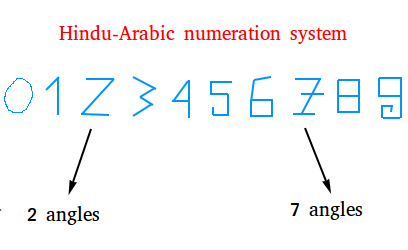Hindu-Arabic numeration system
The Hindu-Arabic numeration system, also called Hindu-Arabic numerals evolved around A.D. 800. It is basically the decimal numeration system that is widely used today. Is the shape of each digit based on the number of angles in the digit?

The following lists 4 main attributes of this numeration system.
First, it uses 10 digits or symbols that can be used in combination to represent all possible numbers.
The digits are 0, 1, 2, 3, 4, 5, 6, 7, 8, 9.
Second, it groups by tens, probably because we have 10 fingers on our two hands. Interestingly enough, the word digit literally means finger or toes.
In the Hindu-Arabic numeration system, ten ones are replaced by one ten, ten tens are replaced by one hundred, ten hundreds are replaced by one thousand,
10 one thousand are replaced by 10 thousands, and so forth...
Third, it uses a place value.
- The first number on the right represents how many ones there are
- The second number on the right represents how many tens there are
- The third number represents how many hundreds there are
- The fourth number represents how many thousands there are
- And so on...
For example, in the numeral 4687, there are 7 ones, 8 tens, 6 hundreds, and 4 thousands.
Finally, the system is additive and multiplicative. The value of a numeral is found by multiplying each place value by its corresponding digit and then adding the resulting products.
| Place values | thousand | hundred | ten | one |
| Digits | 4 | 6 | 8 | 7 |
The numeral value is equal to 4 × 1000 + 6 × 100 + 8 × 10 + 7 × 1 = 4000 + 600 + 80 + 7 = 4687
Notice that the Hindu-Arabic numeration system requires fewer symbols to represent numbers as opposed to other numeration systems.
The Hindu-Arabic numeration system and word names.
Each Hindu-Arabic numeral has a also word name. Here is short list:
| 0:Zero | 10:Ten |
| 1:One | 11:Eleven |
| 2:Two | 15:Fifteen |
| 3:Three | 20:Twenty |
| 4:Four | 34:Thirty-four |
| 5:Five | 40:Forty |
| 6:Six | 100:One hundred |
| 7:Seven | 590:Five hundred ninety |
| 8:Eight | 5083:Five thousand eighty-three |
| 9:Nine | 56000:Fifty-six thousand |
- Numbers from 1 through 12 have unique names.
- Numbers from 13 through 19 have "teens" as ending and the ending is blended with names for numbers from 4 through 9.
- For numbers from 20 through 99, the tens place is named first followed by a number from 1 through 10.
- Numbers from 100 through 999 are combinations of hundreds and previous names.
What are the advantages of the Hindu-Arabic number system?
The use of abacus to do math calculations had many disadvantages. For example, the abacus is hard to learn and it may take a long time to perform calculations.
On the other hand, the Hindu-Arabic number system is easy to learn and calculations can be done easily and quickly with paper and pencils. This is why mathematicians and merchants really love this numeration.